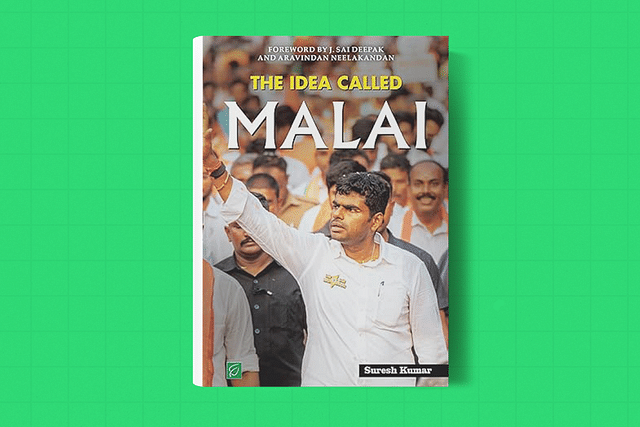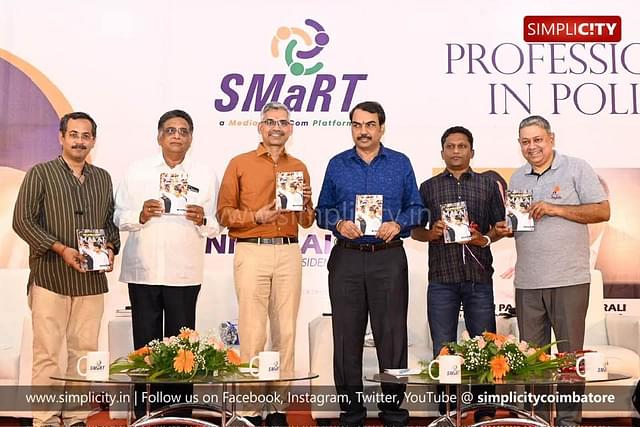Tamil Nadu
A Record Of The Annamalai Phenomenon From A Skeptic-Turned-Admirer
Aravindan Neelakandan
Apr 11, 2024, 07:04 PM | Updated Apr 12, 2024, 12:34 PM IST
Save & read from anywhere!
Bookmark stories for easy access on any device or the Swarajya app.

The Idea Called Malai. Suresh Kumar. Oxygen Books, New Horizon Media. Pages: 176. Rs 250.
There are moments in history when an individual becomes a phenomenon. Expectations of people, need for change and confidence in a charismatic leader, all come together to make an individual the focus of an entire people.
Such a moment seems to be playing out right now in Tamil Nadu in the name and form of K.Annamalai.
The book under review, The Idea Called Malai delves into the heart of this phenomenon. It uncovers the shifting landscape of expectations and justifies the faith the people of Tamil Nadu have placed in Annamalai’s leadership for the future of their state.
This book offers a compelling insight into why Annamalai is seen as a beacon of hope for the future.
Author Suresh Kumar, a professional Chemical Engineer and an MBA in Systems, has multiple dimensions: IT entrepreneur, consultant for multinational clients, and a social media writer. Even his signature satire veils but does not entirely hide his in-depth knowledge of the state of economy and tech-ecosystem. His endorsement of Annamalai is thus a signal that winds of change may indeed be blowing in the state.
The book explores Annamalai phenomenon through the author's own experience of politics and social change. From TV debates to observing political developments closely, author captures its essence and possible consequences for Tamil Nadu to the readers.
Annamalai is admired for his humility, daring stance, and no-nonsense approach, as the author perceives through keen observation and personal experience.
For instance Annamalai is known for the ‘controversy’ of not giving due respect to the press and he is also accused of humiliating them. Those clips are viral in the social media. But truth be told, many enjoy Annamalai 'humiliating' the press. Yet this is not the reality. If Annamalai only insults the press, then it is easy for the press to boycott him or picture him as intemperate politician. Why they could not do it is, because Annamalai answers the toughest of the questions with sincere effort and with data. It is only when the questions are unprepared, frivolous and intentionally malign and without substance that Annamalai answers in kind. Author explains:
He often meets the press and answers all their questions that deserve respectful answers. He takes all kinds of questions in public, even the ones that criticise him or his actions or his party. The question can be harsh, but he takes it if it has some merit and should be answered. But once he decides to answer it, there will be a 100% sincere effort to provide genuine answers. He goes to the root of the question to address it. He presents the simple facts, sets the narrative, and counters the narrative set to him.
The book is unapologetic and honest with respect to what it is. The author sees a revolution of sorts happening in Tamil Nadu. He feels he should be part of it and hence this book. He writes:
Since Malai came to the party, the party’s social media presence has expanded. Expansion is not retweeting and resharing but creating original content supporting Malai and TN BJP. The like-minded supporters of the party participated in discussions and expressed their interest in working for Malai. The pro-Malai, pro-Modi, and pro-BJP space has been increasing, while there were several PROs for the party and Malai. This includes me and this book.
The book is both a narration of ‘Annamalai phenomenon’ as well as a source of feedback to Annamalai - of how a sceptic-turned-admirer views him and what he expects. The book will be an important document in ages to come.


The book was released in a function organised by 'Smart' (link) 'a platform for nationalistic media and mass communication' on 6 April, Coimbatore. But the function itself ran into difficulties. The organisers had to face obstacles created by the district administration, though it was an indoor event.
Finally the organisers obtained permission through the court to conduct the event successfully. The book has been translated into Tamil by B.R.Mahadevan, writer and translator who had earlier translated Dharmapal's Beautiful Tree into Tamil. The Tamil book has been published by Kizhaku Publishers. The translation is lucid and does justice to the subject matter.
Link for purchasing the English book: here; Tamil book: here
Save & read from anywhere!
Bookmark stories for easy access on any device or the Swarajya app.
Support Swarajya's 50 Ground Reports Project & Sponsor A Story
Every general election Swarajya does a 50 ground reports project.
Aimed only at serious readers and those who appreciate the nuances of political undercurrents, the project provides a sense of India's electoral landscape. As you know, these reports are produced after considerable investment of travel, time and effort on the ground.
This time too we've kicked off the project in style and have covered over 30 constituencies already. If you're someone who appreciates such work and have enjoyed our coverage please consider sponsoring a ground report for just Rs 2999 to Rs 19,999 - it goes a long way in helping us produce more quality reportage.
You can also back this project by becoming a subscriber for as little as Rs 999 - so do click on this links and choose a plan that suits you and back us.
Click below to contribute.





